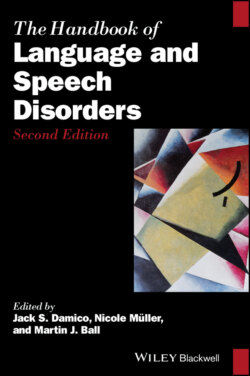Читать книгу The Handbook of Language and Speech Disorders - Группа авторов - Страница 34
2.5.3 Language and Diversity in Acquisition
ОглавлениеContext, the main generator of linguistic diversity, is also an instigator of variation in language acquisition. Language may refer to any linguistic code, whether it is an actual spoken language, a dialect, a non‐spoken (manual/signed) language, or a communication modality. Acquisition refers to both implicit (unconscious) and explicit (conscious) learning; it may also involve naturalistic situations, instructional settings, or combination(s) of both. Acquisition may take place endogenously or exogenously in terms of whether the language(s) targeted is the ambient one or not (i.e., the language of the environment or the larger community), in monolingualism, bilingualism, multilingualism, bilectalism/bidialectalism (two dialects), multilectalism/multidialectalism (many dialects), heritage language (home language different from community language), or diglossia; among these one also finds passive use, that is, the speaker comprehends but purposely refrains from speaking. It is worth noting that the state of being bilingual (in the senses just delineated and irrespective of proficiency levels) incorporates aptitude (langue) and skill (parole) on both the linguistic and the cultural terrain since, as mentioned earlier, linguistic symbols are interpretations of cultural entities, often non‐translatable, as in the case of la Día de los Muertos, la quiche, yin‐yang or φιλότιμο .
Context may also affect language acquisition and its outcomes in terms of the age, timing, degree, and length of exposure to linguistic input, the quantity and quality of linguistic input, the number of languages, executive processing, the actual course of development, universals, and individual variation, patterns of interference, language status and dominance, social and affective factors, and in terms of the end result, sometimes referred to as ultimate attainment, with regard to nativeness or native‐likeness, fluency, proficiency, presence or absence of accent, language attrition and loss, and so on. These are all factors that give rise to a number of related terms and definitions in language acquisition research, the most predominant of which have already been mentioned, but there is also an abundance of them less cited, whose sheer enumeration serves as further evidence of the diversity witnessed in language acquisition patterns (see Babatsouli & Ball, 2020).
The acquisition of language is investigated by three to four main fields in applied linguistics, primarily distinguished into: first language (monolingual), bilingual and/or multilingual (terms with decisively overlapping semantics), and second language acquisition, that is, FLA, bilingualism, multilingualism, and SLA, respectively. Further convergence is identified across these fields in that bilingual and multilingual child development may also be considered relevant in the study of first language acquisition (as in simultaneous acquisition of languages) or second language acquisition (as in successive acquisition of languages), as well as in the fields of bilingualism/multilingualism. Similarly, the study of second (or third, fourth, etc.) language acquisition in adulthood (meaning post‐puberty) may still fall within the regimen of the study of bilingualism or multilingualism.
A more up‐to‐date categorization of language acquisition prototypes purposely overlooks, without dismissing, the clutter of confusing variation that one needs to account for when deciphering language acquisition patterns, which advances the critical period hypothesis (CPH) as a rough gauge to differentiate between language acquisition models. The CPH advocates that there is an end point in human maturation (brain plasticity) beyond which the capacity for language is encumbered. In other words, the CPH determines the breaking point between protolanguage, child (pre‐puberty) language development (a dynamic process), and interlanguage, adult (post‐puberty) language development (also a dynamic process). In this manner, language and its acquisition are viewed as a cohesive whole across contexts. More targeted discussions of all the themes outlined in this section may be found in Babatsouli and Ball (2020), and Babatsouli and Ingram (2018), and references therein.
What one really needs to take home is that protolanguage and interlanguage share similarities (universals) and differences that surface intact in child and adult SLDs in monolingual and non‐monolingual contexts. Comprehensive assessment, diagnosis, and intervention of SLDs is hampered without expertise in or, at least at the most rudimentary level, familiarity with these topics which are crucial in disentangling difference from disorder, as well as in decoding and employing for the best the dynamic processes involved in SLD rehabilitation.
In fact, this is where the clinical service provider needs to be lingual, that is, a linguist. Furthermore, it goes without saying that investigating, assessing, and intervening in frameworks engaging language(s) requires competence (at the underlying level) as well as performance (at the surface level) of the language(s) in question. This means that in order for a clinical service provider to be clinically competent, she also needs to be linguistically adept in the client’s language(s). In view of the heightened awareness of how multilingual our monolingual societies actually are on a local and worldwide scale, the ASHA suggestion is that SLPs should aim toward enhancing second‐language ability and practice as part of their required clinical competence. This is where the clinical service provider needs to be lingual in yet another sense, that is, to be bilingual herself. Bilingual skill translates into bilingual service provision (BSP). ASHA promotes BSP because the clinician is more aptly qualified to communicate and serve, at least, in the contexts of the two language/cultures concerned (https://www.asha.org/Practice‐Portal/Professional‐Issues/Bilingual‐Service‐Delivery).
